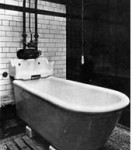A walk around Victoria Baths
Article published: Wednesday, September 29th 2010
 In preparation for Manchesters’ local history fair, Victoria Baths received a portrait of one of Longsight’s most famous sons – Rob Derbyshire the Olympic swimmer who learnt his strokes in the Edwardian pools. In this two part feature the MULE’s Michael Pooler looks at a building building steeped in history and sociological significance.
In preparation for Manchesters’ local history fair, Victoria Baths received a portrait of one of Longsight’s most famous sons – Rob Derbyshire the Olympic swimmer who learnt his strokes in the Edwardian pools. In this two part feature the MULE’s Michael Pooler looks at a building building steeped in history and sociological significance.
Part 1: The Tour
Two weeks ago saw the arrival – or rather the long-awaited return – of Rob Derbyshire to Victoria Baths, in the form of a portrait painted in 1948. Depicted proudly in a swimming suit bearing the insignia of Great Britain the portrait is a fitting tribute to a man who was once a feted star in this part of Manchester. Rob won an Olympic gold medal as part of the GB water polo team in 1900, while later taking them to the 1936 Games as a trainer.
“In those days Rob Derbyshire would have been a local hero, like Premier League stars today”. My volunteer tour guide Barry Johnson tells me. On match days the seated balconies which encircle the principle pool would be teeming full of supporters at water polo matches – back then a hugely popular sport.
But there is more to the baths than hero worship. Barry continues “the baths are fascinating and rich in social and political history. Whereas most organisations involved in the preservation of sports facilities focus only on the records and achievements of celebrated sportsmen and women, we are interested in ordinary people and their experiences”.
Upon walking through the main entrance of the baths you are struck immediately by its magnificence: brilliant emerald green tiles fired in Salford adorn the walls; floors covered by mosaic patterns; and luxurious fully ceramic banisters lead upstairs. It is little wonder that the building is Grade II listed. So it remains a matter of some mystery why to this day it has only been partially restored. Built in 1906 by the Council, it was the main swimming pool in Manchester for 86 years until its closure in 1993 when it was considered too expensive to keep running. Since then a dedicated group of volunteers – the Friends of Victoria Baths – have worked towards its restoration.
Our tour starts in the pool’s basement archives which house hundreds of documents and objects related to the baths such as trophies, swimming costumes and minute-books of association meetings. It also boasts a large audiovisual collection with interviews from residents recounting their memories of the baths. The museums curators are keen to impress the importance of this aspect of the collection, with particular emphasis on social history and maintaining the oral tradition by passing history from one generation to another by spoken word.
Original Use
As we talk about the origins of the baths, my guide puts to rest oft-repeated myths which portray Public Baths as a benevolent gift from philanthropists of the period. While this was a factor in their creation, there was also a degree of self-interest – namely, concerns of public health and hygiene.
“In Manchester at the turn of the 20th Century the working and middle classes lived in greater proximity to one another. The wealthy were worried about diseases spreading from the lower class areas to their own and so the baths were built as part of a public health programme”.
The baths originally consisted of three pools: men’s first class, men’s second class and the ladies’ pool. While it is easy to attribute the gender separation to prevailing social cultural norms of the era, the distinction of quality – based upon the ability to pay – is revealing of social attitudes and how class played a defining role in society.
Class issues
Even the engineering of the swimming pools tells uneasy truths about social stratification of the day and sheds light on the treatment of lower social classes – especially women. The pools were fed with water for many years by a nearby Artesian well, dug deep into the ground. Water would be pumped into the first class pool and, on entering its filtration system, would then be recycled first into the men’s second class and finally the ladies’. What this meant was men who could not afford the most expensive tariff would swim in increasingly dirty water while women were effectively treated as sub-citizens, permitted only to bathe in the muck of others. This is echoed in the decoration: while the first class entrance is one of breathtaking Edwardian elegance, the others are far less ornate and more functional.
Such an arrangement would of course be unthinkable nowadays in our society where equality and eliminating discrimination are sacrosanct – even though such ideals are not upheld in practice. For it requires no more than a quick examination of private member gyms facilities compared with decrepit public leisure centres to see how new forms of social division manifest and justify themselves.
From this perspective the building is a case study in how the management of public spaces has a subtle – but extremely powerful – effect of social control. The easing of gender segregation began a gradual process from 1914 onwards, however my guide tells me of how there is a growing demand for women only swims nowadays, in particular from the Muslim community.
Part 2 of the feature takes a further look at the cross-section of Manchester society painted by the baths and the future of the building. Look out for it later this week on the MULE website.
This article originally appeared in an unabridged form on the Now Then Manchester website, a free independent monthly magazine born from grass roots culture, community and entertainment.
http://nowthenmanchester.blogspot.com/
More: Features, Manchester
Comments
No comments found
The comments are closed.



